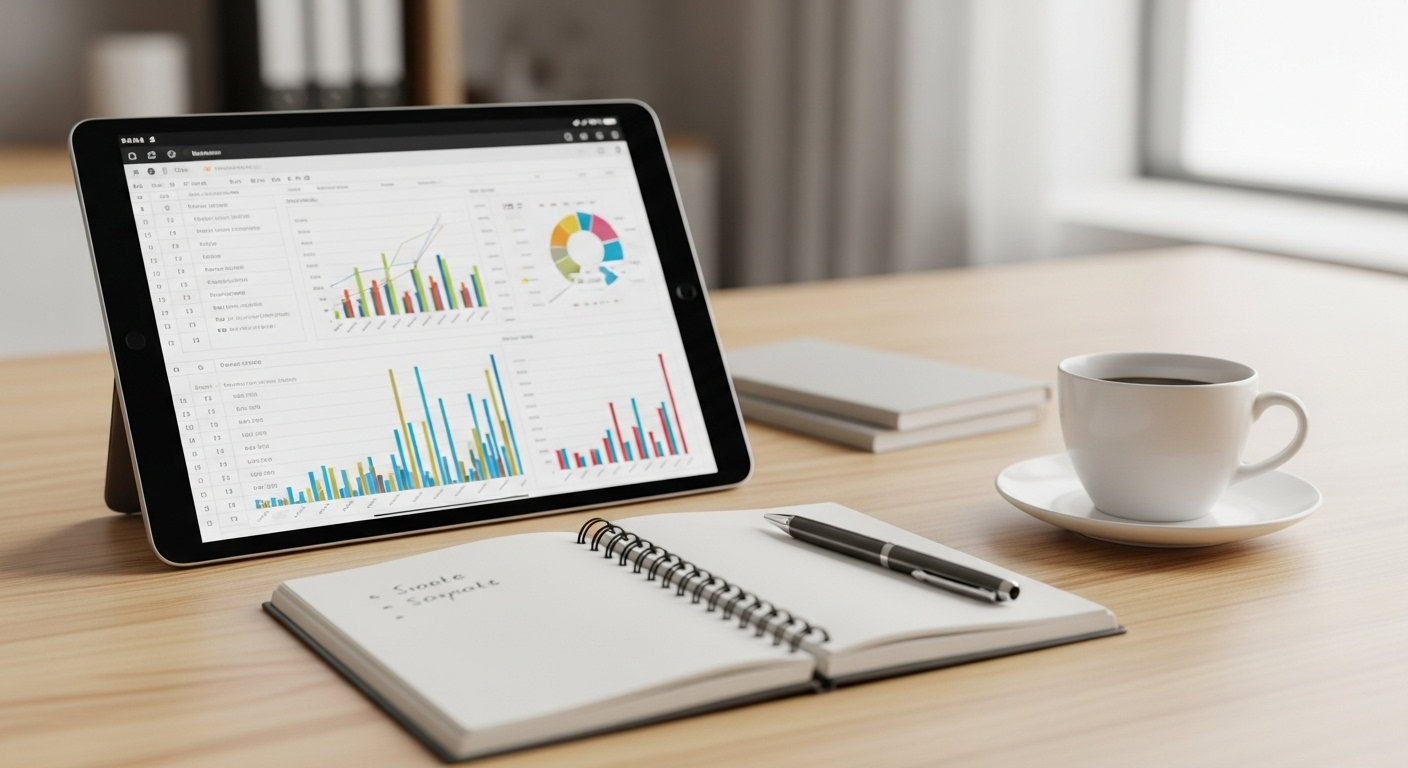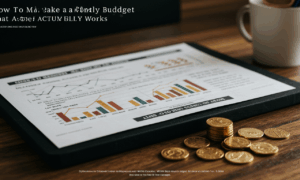How to Make a Personal Budget? A Step-by-Step Guide to Financial Control
Do you ever feel like your money disappears before the end of the month, leaving you wondering where it all went? This lack of financial control can be a significant source of stress. The solution is simpler than you might think: creating a personal budget. Far from being a restrictive financial straitjacket, a budget is a powerful tool that empowers you to take command of your finances, achieve your goals, and build a more secure future. This guide will walk you through, step by step, how to create a functional and effective personal budget that works for you.
Understanding how to make a personal budget is the first and most critical step toward financial literacy and independence. It is the roadmap that guides your spending, saving, and investing decisions, ensuring that your money is working for you, not against you.
The Power of a Budget: Why It’s Your Best Financial Tool
Before diving into the mechanics, it is essential to understand why budgeting is so crucial. A well-crafted budget provides clarity and direction. It transforms abstract financial goals, like buying a home or retiring comfortably, into a series of achievable monthly actions. By tracking your income and expenses, you gain a precise understanding of your financial habits, identifying areas of overspending and opportunities for savings.
The primary benefits of maintaining a budget include:
- Financial Control: You decide where your money goes, rather than letting impulsive spending dictate your financial health.
- Goal Achievement: A budget helps you allocate funds systematically toward your short-term and long-term goals.
- Debt Reduction: By identifying surplus cash, you can create an aggressive strategy to pay down high-interest debt faster.
- Stress Reduction: Knowing you have a plan for your money and can handle unexpected expenses reduces financial anxiety.

Step 1: Calculate Your Total Net Income
The first building block of any budget is knowing exactly how much money you have coming in each month. This is your total net income, which is the amount you receive after taxes, insurance premiums, and other deductions are taken from your paycheck. It is crucial to work with this take-home pay, not your gross salary, as it reflects the actual funds available to you.
To calculate your total net income, list all sources of monthly revenue:
- Primary Salary: Your main job’s take-home pay.
- Secondary Income: Earnings from part-time work, freelance projects, or a side hustle.
- Other Income: Any other regular cash flow, such as rental income or government benefits.
If your income is irregular or varies from month to month, a good strategy is to calculate your average monthly income over the past six to twelve months. Alternatively, you can base your budget on your lowest-earning month to ensure you can always cover your essential expenses.
Step 2: Track and Categorize Your Expenses
This is often the most eye-opening step. To create an accurate budget, you must know where your money is going. For at least one month, meticulously track every single expense. You can use a dedicated budgeting app, a spreadsheet, or a simple notebook. The key is to be thorough. At the end of the tracking period, group these expenses into logical categories.
Your expenses generally fall into three types:
- Fixed Expenses: These are costs that remain the same each month and are typically non-negotiable. Examples include rent or mortgage payments, insurance premiums, loan repayments, and recurring subscriptions like a gym membership or streaming services.
- Variable Expenses: These costs fluctuate from month to month and are where you have the most control. This category includes groceries, dining out, transportation fuel, utilities (which can vary), and entertainment.
- Periodic or Non-Monthly Expenses: These are expenses that do not occur every month but can significantly impact your budget if you do not plan for them. Think of annual car maintenance, holiday gifts, property taxes, or yearly subscriptions. A great way to manage these is with a sinking fund, where you save a small amount each month specifically for these future costs.
Step 3: Analyze Your Spending and Set Financial Goals
With your income and expenses clearly laid out, it is time for analysis. Subtract your total monthly expenses from your total monthly income. If you have money left over, you have a surplus. If you are spending more than you earn, you have a deficit. This simple calculation reveals your current financial reality.
Now, compare your spending habits with your long-term goals. Is your discretionary spending on dining out preventing you from reaching your savings goals? This is the moment to make conscious decisions about aligning your spending with your priorities. Use the SMART (Specific, Measurable, Achievable, Relevant, Time-bound) framework to define your objectives. For example, instead of a vague goal like “save more money,” a SMART goal would be “save $6,000 for a home down payment over the next 24 months by contributing $250 per month.”
Step 4: Choose a Budgeting Method That Works for You
There is no single best way to budget; the most effective method is the one you can stick with consistently. Here are a few popular and proven approaches:
- The 50/30/20 Rule: This is a straightforward method ideal for beginners. You allocate 50% of your net income to Needs (fixed expenses like housing and transportation), 30% to Wants (variable expenses like hobbies and entertainment), and 20% to Savings and Debt Repayment.
- Zero-Based Budgeting: With this detailed method, you assign a specific purpose to every single dollar of your income. Your income minus your expenses should equal zero. This approach forces you to be highly intentional with your money and is excellent for maximizing savings and eliminating debt.
- The Envelope System: This is a cash-based system for managing variable spending. You allocate a set amount of cash into labeled envelopes for categories like “Groceries” or “Entertainment.” Once an envelope is empty, you cannot spend any more in that category until the next month. It is a very tangible way to prevent overspending.
Step 5: Implement, Review, and Adjust Your Budget
A budget is not a “set it and forget it” document. It is a living plan that needs to adapt to your life. Your income might change, your expenses could increase, or your financial goals might evolve. For this reason, it is crucial to review your budget regularly—at least once a month.
During your review, check your progress. Are you sticking to your spending limits? Are you on track to meet your savings goals? If you find you consistently have a surplus, decide what to do with that extra money. You could accelerate your debt repayment, boost your emergency fund, or explore investment opportunities. If you are facing a deficit, identify which variable spending categories can be reduced. Be realistic and make adjustments as needed. The goal is progress, not perfection.
Conclusion: Taking Control of Your Financial Future
Creating and maintaining a personal budget is the cornerstone of sound personal finance. It is the process of building a deliberate plan for your money, giving you the clarity and confidence to make smart financial decisions. By following these steps—calculating your income, tracking your expenses, setting clear goals, choosing a method, and reviewing your progress—you can move from financial uncertainty to a position of strength and control. Your financial future is in your hands, and your budget is the tool to shape it.
Frequently Asked Questions (FAQ)
What are the best tools for creating and tracking a budget?
The best tool depends on your personal preference. Many people find success with digital spreadsheets like Google Sheets or Microsoft Excel, as they are highly customizable. There are also numerous budgeting apps (such as Mint, YNAB, or PocketGuard) that can link to your bank accounts and automatically categorize transactions. For those who prefer a more hands-on approach, a simple notebook and pen can be just as effective.
How can I stick to my budget when unexpected expenses come up?
Unexpected expenses are a part of life, and a good budget accounts for them. The best defense is a well-funded emergency fund—a separate savings account with three to six months’ worth of essential living expenses. When an unexpected cost arises, you can cover it with these funds without derailing your budget. If you do not yet have an emergency fund, you may need to temporarily reduce spending in flexible categories, like entertainment or dining out, to cover the cost.
My income is irregular. How can I create a budget that works?
Budgeting with a variable income requires a different approach. The most common strategy is to create a baseline budget based on your lowest anticipated monthly income. This budget should cover all your essential needs. In months when your income exceeds that baseline, you can allocate the extra money toward specific goals, such as paying down debt, boosting savings, or investing. This method ensures your core expenses are always covered while allowing you to make significant financial progress during higher-earning months.



